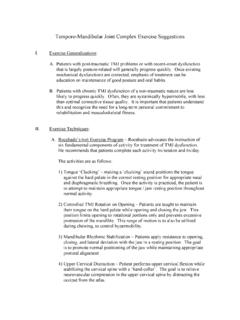Transcription of Initial driving position and posture guide
1 Initial driving position and posture guide Take the time to familiarise yourself with ALL the adjustments ( seat, steering wheel, seat belt). Start by getting the seat into the Initial set up position ', where adjustable: Steering wheel fully up and fully forward Seat height at its lowest Cushion tilted so that front edge in lowest position Back rest approximately 30 degrees reclined from vertical Lumbar support adjustment backed off Seat fully rearwards Suggested sequence of adjustments for highly adjustable driving packages 1. Raise the seat as high as is comfortable to improve your vision of the road. Check you have adequate clearance from the roof.
2 Ensure you have maximum vision of the road. 2. Move the seat forwards until you can easily fully depress the clutch pedal and accelerator pedal. Adjust seat height as necessary to give good pedal control. 3. Adjust cushion tilt angle so that the thighs are supported along the length of the cushion. Avoid pressure behind the knees. 4. Adjust back rest so it provides continuous support along the length of the back and is in contact up to shoulder height. Avoid reclining the seat too far as this can cause excessive forward bending of the head and neck and you may feel yourself sliding forwards on the cushion. 5. Adjust the lumbar support to give even pressure along the length of the back rest.
3 Ensure lumbar support fits' your back, is comfortable with no pressure points or gaps. Compiled by the team at 6. Adjust steering wheel rearwards and downwards for each reach. Check for clearance for things / knees when using pedals. Ensure panel display is in full view and not obstructed. 7. Adjust the head restraint to ensure the risk of injury is reduced in the event of a car accident Repeat stages 1-7 and fine tune as necessary Be aware that many cars will not allow you as much flexibility of driving posture as you may like. Particular cars may cause you to adopt a coping' posture . For example, limited headroom forces a reclined posture , making reach to the steering wheel a problem.
4 This leads to excessive forward bending of the head and neck and a slouched' posture . DISCLAIMER. While Loughborough University endeavours to ensure that the information in this leaflet is correct, Loughborough University does not make any representations or warranties, either express or implied, as to the accuracy or completeness of the information on this leaflet nor its fitness for any purpose whatsoever. Although efforts have been taken to ensure the accuracy of the information in these pages, continuing research is required to establish the effectiveness of the information contained within this website. Loughborough University does not therefore guarantee the completeness and correctness of the information contained within this leaflet and will not be held responsible for any errors or omissions.
5 Loughborough University (including any employee, academic, student or other such persons involved in creating the leaflet) will not be liable or responsible for any loss, damages, costs or expenses, howsoever or wheresoever incurred (including without limitation, any direct, indirect, punitive or consequential loss or damages), resulting from the use of any of the information within this leaflet. The information provided is subject to change at any time and does not constitute business, medical or other professional advice and does not form any basis of a contract with readers or users of this leaflet. All employers have a responsibility to check all health and safety legislation, regulations and guidance which might apply to all employees.
6 Compiled by the team at







